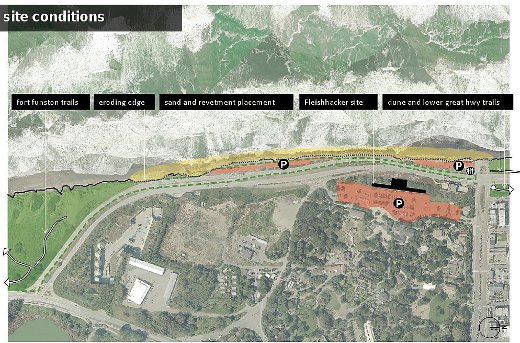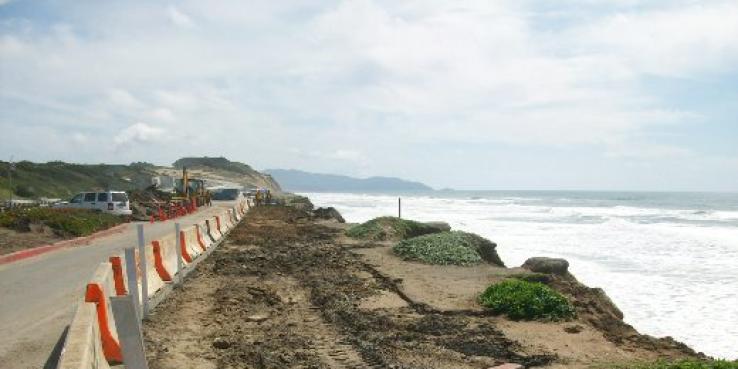SPUR, along with agency partners and design consultants from AECOM, has begun work on an Open Space Design for recreational and landscape improvements on Ocean Beach and surrounding streets and trails. Initial efforts will focus on the parking area and bluffs south of Sloat Boulevard. The Open Space Design is an adaptive plan that follows the natural progression of the beach and bluffs. With different parts of the beach eroding at varying speeds, the design team is exploring creative ways to adapt to coastal changes. The design is driven by the guiding principle of managed retreat on the South part of the Great Highway that will allow for dune and bluff restoration as recommended by the OBMP. Near-term open space and access improvements will become possible thanks to the Department of Public Works (DPW) plans for narrowing the Great Highway and to funding granted from Coastal Conservancy. These changes will make Ocean Beach a much better public space for all to enjoy.
Near-term improvements
The immediate coastal protection plan that covers the next three storm seasons will offer some exciting landscape opportunities in the very near future, with improvements to access and beach aesthetics. The transient nature of the landscape poses many design challenges but also creates opportunities to celebrate this temporary environment, for instance through public art elements. The interim reconfiguration of the Great Highway South of Sloat creates recreational opportunities, which could include a temporary pedestrian and bike trail, in the vacated southbound lanes and parking areas. It also allows for the removal of excess asphalt, beach cleanup and re-vegetation. Brushwood and other natural materials will minimize effects of windblown sand and greatly improve beach aesthetics while channeling pedestrian access in a way that won’t compromise the beach.
Long-term design

One of the major goals of the Open Space Design is to create connections between Ocean Beach and the surrounding recreational areas. Image courtesy of AECOM.
The interim Open Space Design will be a precursor of the long-term vision. A network of interconnected pedestrian and bike trails will link Ocean Beach smoothly to Fort Funston, San Francisco Zoo, Lake Merced and Golden Gate Park, as well as the existing dune and Lower Great Highway trails. The Fleischhacker Pool House site emerges as a great connection point between the Zoo and the coast, with opportunities to engage the Zoo’s conservation mission. Parking areas will be re-organized to improve experience for beach goers while maintaining good coastal access. Green infrastructure opportunities in the new parking areas and along the site’s thoroughfares will beautify the streetscape while retaining and infiltrating stormwater. The intersections of Great Highway/Sloat and Sloat/Skyline have been identified as key important gateways to the improved landscape, and could include elements like interpretive signage and bike parking. New locations will be determined to host amenities like restrooms, seating, and scenic overlooks.
Next Steps
The Open Space Design study enables further collaborations between the different OBMP partner agencies for joint management of the open space areas and facilities. These include the GGNRA, SF Department of Public Works, SF Recreation and Park Department, and SF Public Utilities Commission. Beach users and community members are invited to help the team develop design and programming ideas during our Open House on May, 10th.
